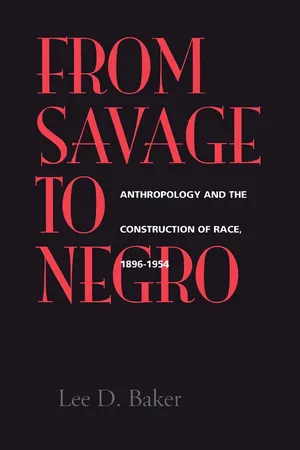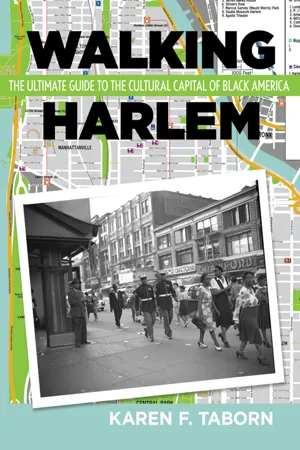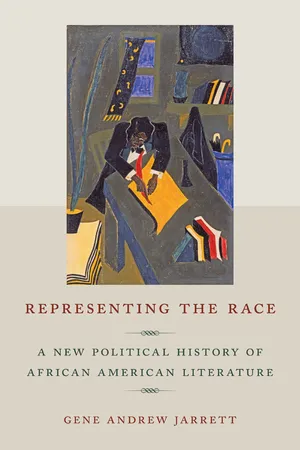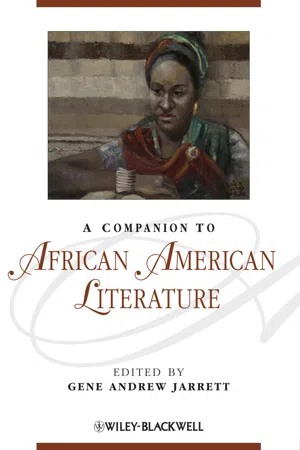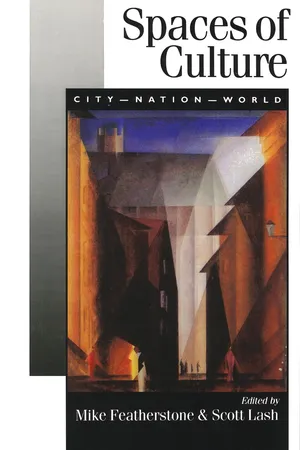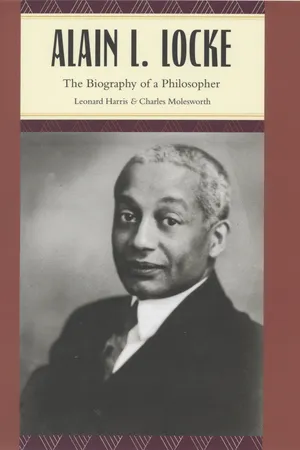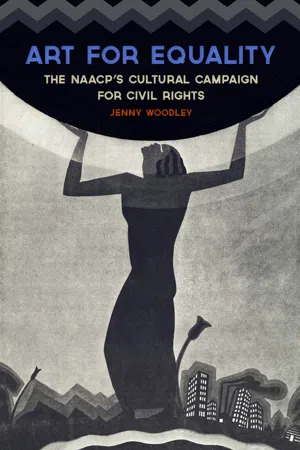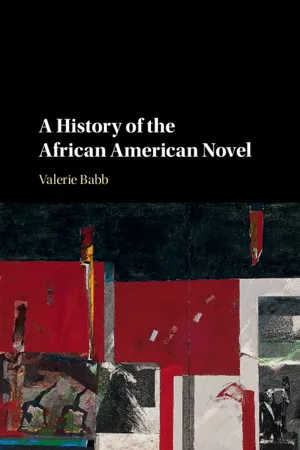History
New Negro Movements
The New Negro Movement, also known as the Harlem Renaissance, was a cultural, social, and artistic explosion that took place in Harlem, New York, during the 1920s. It marked a period of renewed pride and self-expression for African Americans, with a focus on celebrating their heritage and challenging racial stereotypes through literature, music, art, and activism.
Written by Perlego with AI-assistance
Related key terms
1 of 5
12 Key excerpts on "New Negro Movements"
- eBook - ePub
Black Art
A Cultural History
- Richard J. Powell(Author)
- 2022(Publication Date)
- Thames and Hudson Ltd(Publisher)
For composer George Gershwin, publisher Frank Crowninshield, theatrical agent and music publisher Irving Mills, and mobster and nightclub owner Owney Madden, the Harlem Renaissance was, to use American slang, “the hook”: a marketing strategy for New York’s publishers, theater producers, nightclub and cabaret owners, and other business people in the 1920s and 1930s. For black artists like Paul Robeson, Langston Hughes, Duke Ellington, and Ethel Waters, as well as black intellectuals like Locke, Du Bois, James Weldon Johnson, and others, this “Negro Renaissance” was an auspicious moment in American cultural life: African Americans had unprecedented access to, and an active role in, the organizations of the mass media, the venues of mainstream entertainment, and cultural institutions.Finally, for many people this “New Negro” entity was not so much a movement, a moment, or even an actual person, as a mood, or a sentiment in which black culture and its practitioners were seen as a valuable part of the larger cultural scene. In a society that had recently suffered a war of tremendous proportions, and was increasingly changing into an urban, impersonal, and industry-driven machine, black culture was viewed, interchangeably, as life-affirming, a libidinal fix, an antidote for ennui, a sanctuary for the spiritually bereft, a call back to nature, and a subway ticket to modernity. The “New Negro” was the perfect metaphor for this moment of great social rupture because, like a medicine-show elixir, it was perceived as the cure for everything.The term “New Negro,” meaning an enlightened, politically astute African American, sprang from the turn-of-the-century, progressive race rhetoric of Booker T. Washington, of Fannie Barrier Williams, advocate of black women’s rights, and from the illustrations for The Crisis and Voice of the Negro of artist John Henry Adams Jr. As a cultural movement, the term “New Negro” entered into popular usage with two, influential publications in 1925: a special edition of the magazine Survey Graphic , entitled Harlem: Mecca of the New Negro ; and an anthology of essays, short fiction, photographs, drawings, and a short play, entitled The New Negro: An Interpretation - eBook - PDF
From Savage to Negro
Anthropology and the Construction of Race, 1896-1954
- Lee D. Baker(Author)
- 1998(Publication Date)
- University of California Press(Publisher)
For the first time there was a concerted ef-fort to challenge the derisive and stereotypical images of African Amer-icans produced by blackface minstrelsy, magazine publishers, and racist science. Henry L. Gates, Jr. has pointed out that to call the Harlem Renaissance a 'New Negro' movement is to describe exactly what its vi-sual and verbal artists sought to create: a largely unregistered, unima-gined image of the Noble Negro that would destroy forever the con-fusing, limited range of black stereotypes that every artist had to confront. 37 The New Negro Movement was, at times, conscripted and auda-ciously promoted by the very intellectuals who saw themselves emerging from it. These intellectuals (far from elite, but not working in factories or keeping someone's house) were attempting to make a racial identity out of an American racial order that still shut them out. This construc-tion was undertaken largely in cultural terms and largely for sociopo-litical reasons. However, attempts to raise race consciousness led to a paradox that traumatized Du Bois and perplexed many others. What many African Americans (save for the followers of the UNIA) were struggling for was integration, equality, and, above all, to be Americans. However, in order to reach this end, the NAACP and other organiza-tions had to mobilize people and foster a sense of us-versus-them. So, on the one hand, they espoused the rhetoric that race does not matter; but on the other hand, to reach the goal of integration, they had to promote the significance of race. 38 To reconcile this paradox and anchor their mobilization efforts, many THE NEW NEGRO AND CULTURAL POLITICS OF RACE 141 Black intellectuals looked to African American culture. In effect, they strove to transform a racial identity into an ethnic identity. However, there were various tensions between the artists, shapers of public opin-ion, and organizers. - eBook - PDF
African American Civil Rights
Early Activism and the Niagara Movement
- Angela Jones(Author)
- 2011(Publication Date)
- Praeger(Publisher)
Chapter 6 The Beginnings of a New Negro In Alain Locke’s famous work The New Negro (1925), he describes the way in which African Americans were forcing a new public image of them- selves. The proliferation of black arts and culture in the public sphere debunked the common stereotypes of black intellectual and cultural in- feriority. Commonly reduced to the Harlem Renaissance, the New Negro Movement represented a pivotal moment when African Americans began to shape a new subjectivity. The “Old Negro” was seen as immoral, sav- age, licentious, and primitive. The “New Negro’s” production of art and an increase in education were proving how erroneous these previous im- ages were. Expanding education and increased literacy created the politi- cal opportunities necessary for the emergence of a New Negro. However, African Americans, such as members of the Niagara Movement, had been attempting to shape this “New Negro” prior to the 1920s and the Harlem Renaissance. The New Negroes held their head high and refused to allow racist dis- course to shape their subjectivity any longer: Locke noted, “The intelligent Negro of to-day is resolved not to make discrimination an extenuation for his shortcomings in performance . . . delivered both from self-pity and con- descension . . . the Negro to-day is inevitably moving forward under the control largely of his own objectives.” 1 This new movement was character- ized by self-respect and the determination to change the status quo. African Americans began to seek “truer self-expression.” 2 Most important, as Locke notes, the New Negro was “an augury of a new democracy in American culture. He [African American] is contributing his share to this new social understanding.” 3 African Americans were publicly creating a new African American habitus through an often bourgeois refinement of sensibilities. After all, this was a new century, a new time, for a new Negro. - eBook - PDF
Walking Harlem
The Ultimate Guide to the Cultural Capital of Black America
- Karen Taborn(Author)
- 2018(Publication Date)
- Rutgers University Press(Publisher)
There was a tendency among the “old guard” of the New Negro movement, however, to distance themselves from poor or working-class Black movements, in order to verify their humanity. For example, W. E. B. Du Bois expressed that younger Harlem artists and writers 162 Walking Harlem were too busy pandering their works to please whites, who yearned to see “primitive” or “underworld” representations of Harlem.2 Thus, everyday and working-class movements and arts were often overlooked or shunned by the New Negro “old guard.” For example, Marcus Garvey’s vastly popular, working-class, UNIA movement and the popu- lar Black musical expression of the blues were often over- looked or looked down on by New Negro elders. The subtext of the New Negro movement was chal- lenged by younger, nonconformist, Black Harlem artists and intellectuals, who although validated as never before through publications and art exhibitions of the era, envi- sioned much broader and bolder self-representations. It was also likely that the younger vanguard also felt there was among the New Negro establishment a dearth of critical self-examination of the diversity and often con- flicting identities among Blacks. For example, inter-Black tensions regarding differences in class or sexual orien- tation and oppression of women had yet to be critically examined. Taking into context the cultural milieu of the United States at the time, the New Negro movement was a daring development; however, it was not bold enough to confine the more progressive Black intellectuals and art- ists, several of whom were advanced far beyond the think- ing of their time. It was necessary for young artists and intellectuals to create the means to express themselves on their own terms. - eBook - ePub
Representing the Race
A New Political History of African American Literature
- Gene Andrew Jarrett(Author)
- 2011(Publication Date)
- NYU Press(Publisher)
3New Negro Politics from Reconstruction to the Harlem RenaissanceFrom Reconstruction to the Harlem Renaissance, the symbolic transition of the “Negro” from “Old” to “New” is one of the more compelling stories of the competition of ideological scripts, especially as they pertain to racial representation, in the United States.1 In 1923, the Reverend Reverdy C. Ransom wrote a poem, “The New Negro,” capturing the trope of the New Negro in all its complexity and optimism:Rough hewn from the jungle and the desert’s sands,Slavery was the chisel that fashioned him to form,And gave him all the arts and sciences had won.The lyncher, mob, and stake have been his emery wheel,TO MAKE A POLISHED MAN of strength and power.In him, the latest birth of freedom,God hath again made all things new.Europe and Asia with ebbing tides recede,America’s unfinished arch of freedom waits,Till he, the corner stone of strengthIs lifted into place and power. Behold him! dauntless and unafraid he stands.He comes with laden arms,Bearing rich gifts to science, religion, poetry and song.2Many intellectuals and scholars specializing in nineteenth- or twentieth-century African American literature have told this story, or some variation or part thereof, about New Negro politics, or the way that intellectual culture, in collaboration with formal politics, has helped to “lift” Negroes into the “place and power” that they, as human citizens, rightly deserved.3 New Negro politics accounts for a cultural formation that sought to overcome the prevailing theme, in more mainstream culture, that African Americans were inferior and unassimilable in American “civilization.” Manifest in contexts of literature—as well as in those of drama, illustrations, and speeches—New Negro politics sought to prove that African Americans, then described as a race, could be uplifted in moral, educational, and cultural ways. The proof lay in the images of uplifted African Americans that permeated African American intellectual culture. The feature was a reincarnation of the political rhetoric of miniature portraiture in early America. The literary historian Eric Slauter states that “certain aesthetic assumptions about likeness, resemblance, and form structured American political thought at its foundational moment.”4 - eBook - ePub
- Gene Andrew Jarrett(Author)
- 2013(Publication Date)
- Wiley-Blackwell(Publisher)
Hurston’s travel narrative makes abundantly clear the ways in which the New Negro abroad was as much an American as an African American, the former identity coming more into relief against the backdrop of black worlds away from home. The period between the wars saw the emergence of an increasingly self-conscious New World Negro, who could use the language of revolutionary radicalism and national self-determination alike to shape a new sense of his own black political identity. Alongside political awareness came an artistic appreciation of the histories and cultural forms blacks in the New World potentially shared with each other, politics and culture combining to create the shadowy sense of a unified black, diasporic, imaginary. This black worldliness represented a shared set of beliefs and mindsets that provided the New Negro with counter-cultural tools to navigate the events of the early twentieth century. But the fractures and differences within New World blackness also came along for the ride, issues concerning color, gender, and sexuality adding nuance and complexity to the African American notion of a color line. Abroad, black double consciousness was tripled by the salient economic distinctions between blacks across the developed and underdeveloped worlds. Nevertheless, in his and her travels at the beginning of the twentieth century, the New Negro traced the contours of a globalizing black world whose variegated cultural, political, and social features still interact dynamically today.BibliographyAllen, Ernest, Jr. “The New Negro: Explorations in Identity and Social Consciousness, 1910–1922.” In 1915, The Cultural Moment: The New Politics, the New Woman, the New Psychology, the New Art, and the New Theater in America . Ed. Adele Heller and Lois Rudnick. New Brunswick, NJ: Rutgers University Press, 1991. 48–68.Carby, Hazel V. “Proletarian or Revolutionary Literature: C.L.R. James and the Politics of the Trinidadian Renaissance.” South Atlantic Quarterly 87 (1988): 39–52.Césaire, Aimé. “Notes on a Return to the Native Land.” In The Negritude Poets . Ed. Ellen Conroy Kennedy. New York: Thunder’s Mouth Press, 1989. 66–79.Du Bois, W.E.B. The Souls of Black Folk - eBook - PDF
Spaces of Culture
City, Nation, World
- Mike Featherstone, Scott Lash, Mike Featherstone, Scott Lash(Authors)
- 1999(Publication Date)
- SAGE Publications Ltd(Publisher)
Radio and recording had begun to play an important role in promoting the fusion of cultural forms and genres, as well as in their dispersion. Like its latter-day counterparts, this new generation in the 1 920s was more accustomed to listening to music in a mediated form and probably more open to converging styles and transgressions than its elders. Langston Hughes, one of the central figures of the Harlem Renaissance had no difficulty fusing jazz and poetry, or of writing poems in rural dialect (something which marked the older generation and which the Old Negro elite looked down upon), thus mixing the 'high-brow ' and the 'low-brow' genres, as wel l as musical and literary forms. Nor did he have difficulty taunting those who did: Let the blare of Negro Jazz bands and the bel lowing voice of Bessie Smith sing ing Blues penetrate the closed ears of the colored near-intellec tuals until they listen and perhaps understand . . . . We younger Negro artists who create now intend to express our dark-skinned selves withou t fear or shame. (Quoted in Floyd, 1 993: 9) This short discussion of the New Negro Movement and the Harlem Renaissance was meant to il lustrate the cultura l praxis of social movements. In this case, the 'social ' movement was, in the eyes of many current social movement theorists, a 'cultura l' and therefore not a 'real ' movement, since politica l power was not its motivating force. Part of my point has been to challenge that very distinction and notion of social movement. The broader aim, however, was to show that the struggle of meaning, how the world is to be understood, is a central part of what social movements are al l about. As Roger Friedland puts it: 'the meaning of society is very much at stake in al l important social movements' (1995: 2). - eBook - PDF
Alain L. Locke
The Biography of a Philosopher
- Leonard Harris, Charles Molesworth(Authors)
- 2010(Publication Date)
- University of Chicago Press(Publisher)
Booker T. Wash-ington, in his The New Negro for a New Century (1900), defined the “New Negro” as patriotic, committed to local community development, and firm but not belligerent in expecting recognition of personal dignity. The his-toric mission of the first “New Negro” was thus economic development and social accommodation. Marcus Garvey offered a radically different defini-tion. Garvey’s organization, the Universal Negro Improvement Association (UNIA) published the Negro World, which had the largest circulation of any black-owned or controlled publication throughout the 1920s, with impres-sive circulation in the Caribbean, Africa, and Europe. Garvey’s “New Ne-gro” was defined as an African population promoting race loyalty, unity, and separately controlled institutions. Claude McKay, Zora Neale Hurston, Eric D. Walrond, J. A. Rogers, Arthur Schomburg, and W. A. Domingo (a Negro World editor in 1919) published in the Negro World prior to their works ap-pearing in Locke’s The New Negro. In 1921, “The New Negro, A Genuine Negro Melodrama” by A. Lincoln Harris was staged in Philadelphia. “The old Uncle Tom” type is shown as a servant of the Hon. Marcus Garvey, while the New Negro stands up in the person of the son of Marcus Garvey and de-mands equality with other races. Weana, an Indian girl, and Garvey’s son want to marry; however, the senior Garvey stops the marriage because she is not black, and the father wants his son to continue his work. Near the end of the play it turns out that Weana really is black, and all live happily. The “New Negro” pursued dignity through race loyalty and independent institutions. Others used the medium of stage presentations to explore the themes of racial equality and simultaneously to present their own definitions of the “New Negro.” Du Bois emphasized the importance of the “New Negro” as an active civil rights campaigner. - eBook - PDF
Art for Equality
The NAACP’s Cultural Campaign for Civil Rights
- Jenny Woodley(Author)
- 2014(Publication Date)
- The University Press of Kentucky(Publisher)
This concentration of poets, novelists, artists, dancers, and musicians was, in part, a product of the massive migration of African Americans out of the South to the cities of the North and Midwest. During the 1920s nearly a million blacks moved from the rural South to the cities. Men and women were drawn to Harlem because of the promise of jobs and the bright lights of city life. James Weldon Johnson called Harlem “the Negro capital of the world.” 3 The Renaissance marked the emergence of what contemporaries termed the “New Negro.” Alain Locke, editor of a key text of the Renais- sance, The New Negro (1925), identified a psychological change in African Americans and the growing assertion of a racial identitya “renewed self- respect and self-dependence.” These New Negroes were the writers, paint- ers, musicians, and others who were, according to James Weldon Johnson, “zealous to be racial, or to put it better, determined to be true to them- selves, to look for the art material within rather than without.” The Renais- sance, he wrote in 1926, is “a movement which embodies self-sufficiency, self-confidence and self-expression, and which is lacking in the old group sensitiveness to the approbation or opinion of its white environment.” 4 As discussed later in the chapter, there was debate about the extent to which the art produced should be “Negro,” rather than “American.” Indeed, there were considerable differences among the types, aesthetics, and philoso- phies of work produced during the Harlem Renaissance. What united the participants, however, was the sense of being part of a movement. A number of NAACP officials played an important role in encourag- ing and shaping that movement, including Walter White, Joel Spingarn and his wife, Amy, and Jessie Fauset. The most significant figures from the association were W. - eBook - PDF
- Valerie Babb(Author)
- 2017(Publication Date)
- Cambridge University Press(Publisher)
Fiercely proud of all that is entailed in being black, he and his peers – both male and female – have found their black identity and with it an inner strength which rules out forever a return to that traditional brand of race relations that characterized lives of their elders” (4). One cannot help but hear overtones of the New Negro movement in Ebony’s description of the time and thinking, as did Henry Louis Gates that this constituted another black renaissance: The third renaissance was the Black Arts Movement, which extended from the mid-’60s to the early ‘70s. Defining itself against the Harlem Renaissance and deeply rooted in black cultural nationalism, the Black Arts writers Black Arts and Beyond: 1960s–1970s 125 125 imagined themselves as the artistic wing of the Black Power movement. Amiri Baraka, Larry Neal and Sonia Sanchez viewed black art as a matter less of aesthetics than of protest; its function was to serve the political libera- tion of black people from white racism. Erected on a shifting foundation of revolutionary politics, this “renaissance” was the most short-lived of all. By 1975, with the Black Arts Movement dead, black culture seemed to be undergoing a profound identity crisis. (“Black Creativity” 74) Writers of the period might well be called the newest of the New Negroes, but Gates sells short the artistry and influence of their works. While many exhibited a stridency of tone and mission, the attention paid to their polit- ical content often eclipsed consideration of their craft. 3 Certainly phrases such as “whitey,” “the man,” or “ofay,” conveyed outrage, but this body of writing was more than the angry literature of an angry time. Painting the novels with the broad stroke “black nationalist” elided their many inven- tive distinctions. Not always receiving their due are the rigor of craft, the invention of language, the juxtaposing of imagery, the aesthetic reimagin- ing of history, and the resituating of the art–politics debate. - eBook - PDF
- Rachel Farebrother, Miriam Thaggert(Authors)
- 2021(Publication Date)
- Cambridge University Press(Publisher)
As the genre whose classic narrative structure mapped the struggle to harmonize self-definition with successful socialization, it seemed the perfect vehicle for showcasing a civic situation where achieving the enfranchised maturity of full citizenship seemed endlessly deferred for many black Americans. Perhaps most importantly, the Bildungsroman modeled and augmented the New Negro movement’s prioritization of youth as its central symbolic and political motif. As Alain Locke suggested, the “Young Negro, in his 72 poetry, his art, his education and his new outlook,” was providing “the promise and warrant of a new leadership.” 4 Indeed, youth served as one of the most contested and significant terms of the Renaissance’s many man- ifestoes and proleptic essays – from Locke’s own “Negro Youth Speaks” to Langston Hughes’s “The Negro Artist and the Racial Mountain,” from Marita Bonner’s “On Being Young, a Woman, and Colored” to the avant- gardist rhetoric of Fire!! That youth carried such talismanic freight was partly because of the moment’s re-energization of what Henry Louis Gates famously called the “trope of the New Negro,” but also reflected the rapid changes to the social and cultural mores of youth occurring nationwide. The Harlem Renaissance coincided with the emergence of an age- segregated social sphere of youth, forged in a series of new commercial entertainment venues and social practices (from dating to movie-going, car-rides to amusement parks) governed less by familial rules than by peer- group regulation. In middle-class African American communities, this helped effect a definite shift in hegemonic gender identities that was frequently experienced as intergenerational conflict. This was true of both masculinities and femininities. - eBook - PDF
Are You Entertained?
Black Popular Culture in the Twenty-First Century
- Simone C. Drake, Dwan K. Henderson, Simone C. Drake, Dwan K. Henderson(Authors)
- 2020(Publication Date)
- Duke University Press Books(Publisher)
The publication of Alain LeRoy Locke’s anthology The New Negro in 1925 functioned as the definitive text of the cultural revolution popularly referred to as the Harlem Renaissance and known by academics as the New Negro Movement. Locke served as a mentor to Black artists and ultimately as dean of black letters and art during the New Negro Movement. Coining the term “New Negro” as a way of recognizing the production of Black art by Black artists as opposed to previous work about Black artists, Locke argues that his anthology concentrates on self-expression and agency. By letting the Negro have her own voice, Locke proposes that a New Negro displaces the Old Negro, who is “more a myth than man,” and humanizes Black people who had theretofore been represented as a formula. He also suggests that urban migration from the South to northern and midwestern industrial centers accounts for the shift from discourse on the “Negro problem” to the recogni-tion of class differentiation among U.S. Blacks. Ethnic diversity, then, also informs the metamorphosis from Old to New Negro, as Harlem itself represented an African diasporic population of Afri-can, Caribbean, and both southern and northern African Americans. While, on one hand, Locke calls for race cooperation, on the other, he offers an Afrocentric manifesto calling for Black artists to appreciate and incorporate “African representation of form.” According to Locke, “A more highly styl-ized art does not exist than the African,” and he uses that assertion for his ultimate mandate: a “racial school of art” to be composed of the younger Black artists of the era. “It is not meant to dictate a style to the young Negro artists,” Locke concedes, “but to point the lesson that contemporary Euro-pean art has already learned—that any vital artistic expression of the Negro
Index pages curate the most relevant extracts from our library of academic textbooks. They’ve been created using an in-house natural language model (NLM), each adding context and meaning to key research topics.

